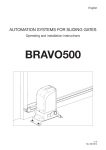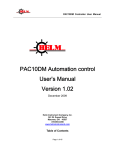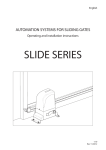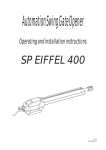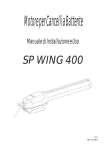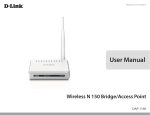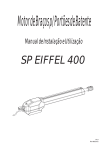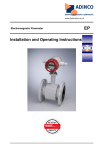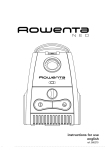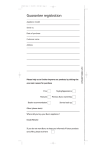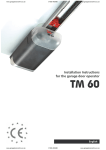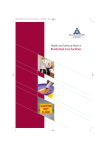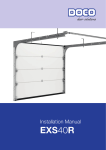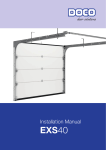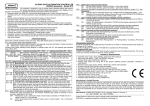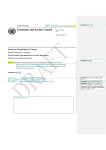Download 08 Concept example risk-assessment RES
Transcript
4-4-2005
concept risk analyses RES
Example/Concept of Risk Analyses for residential overhead doors.
Description of product:
RES-X, RES-70, RES-200
NB! This document is only an example of how a risk assessment could be fullfilled. No rights can be withdrawn from this. The final risk analyses is the responsibillity
of the producer and installer of the overhead door. Check this example/concept with your own interpretation of mentioned risks.
This risk analyses is subject to change without prior notice. State-of-the-art solutions might be introduced after the issue date of this concept.
Standards:
EN13241-1; EN12604; EN12605; EN12453
Hazard identification Acc.
EN 12604
Mechanical
Crushing
NR.
4.5.1; 4.5.2;
4.7.2; 4.10
R = Risk value after action
R = Risk value
A = Adverse event
P = Probability
Observation (during operation)
HO=Hand operated
DO=Drive operated
E = Exposure
Annex A
EN12604
Relevant Clause EN12453
C = Consequence
Operation of the RES-X Door
RES springs in back
RES springs in front
Mode of operation:
Who
Remarks
Completed
4.1.1; 4.4.1; 4.4.3;
4.4.4; 4.4.6
C1
Of fingers/hand between 2V and door leaf (pendel) when hand op. and hand is
placed on the side of the panels
X
X
2
1
1
2
4
-
-
C2
Of fingers between the end caps of the panels when door is closing (HO)
X
X
1
2
2
1
3
-
-
C3
Of fingers between the end caps of the panels when door is closing (DO)
X
X
1
1
1
1
1
-
-
C4
Of fingers or arms between the closing door leafs and the opening in the building
(HO)
X
X
2
2
2
2
8
C5
Of fingers or arms between the closing door leafs and the opening in the building
(DO)
X
X
2
1
1
2
4
-
-
C6
Of fingers in openings of the spring winder
X
1
1
1
2
2
-
-
C7
Of fingers in openings of the spring winder
2
1
1
2
4
-
-
C8
Of fingers between cable and drum when door is closing (initially) (HO)
X
2
1
1
2
4
-
-
C9
Of fingers between cable and drum when door is opening (HO)
X
X
2
1
1
2
4
-
-
C10
Of persons underneath a closing door (DO)
X
X
1
1
2
2
4
Consequence = 1 Drive will reverse when contact force >200N
-
C11
Of finger between door leafs
X
X
2
1
1
1
3
Probability = 1 Finger safe panels
-
C12
Crushing of the head of tall people and low garage height between upper door leaf
and obstacles when door is opening (DO) and door height = 2m
X
X
2
1
1
2
4
All rights are reserved.
X
Page 1 of 5
x
6
-
Subject to change
4-4-2005
concept risk analyses RES
C13
Bystanders getting crushed under a remote operated door
X
X
1
1
2
2
4
Consequence = 1 Drive will reverse when contact force >200N
-
C14
Damaged cars due to not fully opened doors (while door is opening trying to drive
out)
X
X
1
2
2
2
4
-
-
C15
Fingers between upper door leaf and protection cover cable pulley
X
2
1
1
2
4
-
-
C16
Fingers between top roller bracket (Nylon bush) and the protection cover cable
pulley
X
2
1
1
2
4
-
-
C17
Fingers between V-section of upper horizontal track and upper door leaf
X
2
1
1
2
4
-
-
C18
Fingers between roller and protection cover cable pulley (HO)
X
2
1
1
2
4
-
C19
Fingers between roller and cable (difference in speed during opening and closing)
X
1
1
2
1
3
-
S1
Fingers between roller axis and cable
X
1
2
2
1
3
-
S2
Fingers between cable and the track of the bend when the door is opening (HO)
X
2
2
1
2
6
S3
Fingers between cable and the track of the bend when the door is opening (DO)
X
2
1
1
2
4
S4
Fingers between roller and lock (female)
X
X
2
2
2
1
7
S5
Fingers between side hinge and lock (female)
X
X
1
2
2
1
3
S6
Fingers between the cable and the cable pulley
X
2
1
1
2
4
S7
Fingers between lock (male) and lock (female) when door is closing (hand operated)
X
X
2
2
2
1
7
S8
Of fingers or arm in the opening between the door leaf and track of the bend (HO)
when the door is closing
X
X
1
2
1
1
1
-
S9
Of fingers or arm in the opening between the door leaf and track of the bend (DO)
when the door is closing
X
X
2
1
1
2
4
-
S10
Of fingers or arm in the opening in the side plate between the door leaf and track of
the bend (HO) when the door is closing or opening
X
X
1
2
1
1
1
-
-
S11
Of fingers or arm in the opening in the side plate between the door leaf and track of
the bend (DO) when the door is closing or opening
X
X
2
1
1
2
4
-
-
Shearing
Cutting
4.5.1; 4.5.2;
4.7.2; 4.10
X
4.1.1
4
Place handles away from side of the door then 2,2,1,2 changing
to 2,1,1,2
-
x
7
-
-
-
x
7
-
4.2.5; 4.5.1
All rights are reserved.
Page 2 of 5
x
Subject to change
4-4-2005
concept risk analyses RES
K1
Cutting fingers on Horizontal track
X
X
1
1
2
2
4
-
-
K2
Cutting fingers on 2V
X
X
1
1
2
2
4
-
-
K3
Cutting on broken glass of window
X
X
1
1
2
1
3
E1
Entanglement of clothing on protruding lock (HO)
X
X
1
2
2
1
3
E2
Entanglement of clothing on protruding lock (DO)
X
X
2
2
2
2
8
E3
On bolts of slide on side hinge
X
X
1
1
2
1
D1
Clothing or hair caught on coupler (DO)
X
2
1
1
D2
Clothing or hair caught on coupler (DO)
X
2
1
D3
Clothing or hair caught on bolts of winderplug (DO)
X
2
D4
Between lower and upper hinge leaf of side hinge during opening of the door (DO)
X
X
D5
On end of spring while turning of the spring (DO)
X
D6
On end of spring while turning of the spring (DO)
D7
When pull cord and drive are both mounted on the door (hanging)
D8
Entanglement
4.5.1
-
4.4.6; 4.1.2
-
-
Warning: no coexistance of drive and lock
x
3
-
-
2
4
-
-
2
2
6
2
x
1
2
2
6
2
x
2
1
1
2
4
-
-
2
1
1
2
4
-
-
X
2
2
2
2
8
4
x
X
X
3
1
2
2
10
8
x
Trapping of persons inside the garage (drive failure)
X
X
1
1
1
1
1
Door can be manually opened from the inside (de-coupling of
the drive and handle present)
-
I1
Hitting the head against the protruding lock
X
X
1
2
2
2
4
-
-
I2
Hitting the head against the lower door leaf
X
X
1
2
2
2
4
-
-
I3
Hitting the head against the protruding handle
X
X
1
2
2
2
4
-
-
Drawing-in/trapping
Impacts
4.5.2
4.3.1; 4.3.2;
4.3.3
All rights are reserved.
4
4.4.2
4.1.3
Page 3 of 5
Subject to change
4-4-2005
concept risk analyses RES
I4
Hitting the head against the drive-motor
X
X
1
2
2
2
4
-
-
I5
Hitting the head against the horizontal tracks
X
X
1
2
2
2
4
-
-
I6
Hitting the head against the leaver for the drive
X
X
1
2
2
2
4
-
-
I7
While remote operated door is closing and closing edge is not seen (dark)
X
X
1
2
2
2
4
Consequence = 1 Drive will reverse when contact force >200N
I8
Rocking of the door when it is manually opened
X
X
1
2
2
2
4
-
F1
Max. Hand force = 150 N
X
X
2
1
1
2
4
F2
Locked door and drive operated
X
X
1
1
1
2
2
Remark in installation and maintenance manual is made on this
issue.
Spring breakage and ejection of loose piece
X
X
1
1
1
2
2
Piece will be at least 1 turn of coil and therefore cannot eject
from axis
-
L1
Upper panel and roller exiting the horizontal track (HO)
X
X
2
1
1
2
4
When the door is open, the springs will break the movement
towards the end of the track. End stop is also present
-
L2
Upper panel and roller exiting the horizontal track (DO)
X
X
2
1
1
2
4
End position of drive will prevent top roller from reaching end
of horizontal
-
Only applicable on top wheel (others are provided with covers)
X
X
2
1
1
2
4
Top roller is hard to reach
-
V1
Door is primarily build up with door leafs and therefore the windows do not have to
be coloured.
X
X
-
-
-
-
-
-
-
V2
Damaged cars due to bad visibility of side edges of the door
X
X
1
2
2
1
3
-
-
Excessive effort (force)
Falling/ejected objects
4.4.1
4.3; 4.4.6
4.3.4; 4.7.1;
4.7.2; 4.9
O1
Loss of stability/overturning 4.2.2; 4.2.3;
4.2.4; 4.2.5
Contact with wheels
4.7.3.3
W1
Insufficient visibility
-
4.4.3
4.1.1
4.2.5
All rights are reserved.
Page 4 of 5
Subject to change
4-4-2005
concept risk analyses RES
Exposure (E)
Probability (P)
Risk value
1-4 : Low risk
5-7 : Average risk
8-10 : Large risk
11-14 : Very large risk
C = Consequence
Adverse Event (A)
Seriousness
1
Small injury (reversible)
2
Serious injury (mostly irreversible)
3
Death
1
Seldom to sometimes
2
Often to continuously
1
Low (will probably not happen)
2
Average (Can happen during lifetime of the machine)
3
High (will happen often)
1
Possible under certain circumstances
2
Hardly possible
E = Exposure
Parameter
Consequence (C)
1
2
3
1
2
1
2
A = Adverse event
1
1
3
5
7
9
2
2
4
6
8
10
1
1
3
5
7
9
11
2
4
6
8
10
12
1
5
7
9
11
13
2
2
6
8
10
12
14
3
P = Probability
For Risks with a value > 4 safety precautions have to be taken. The following order has to be followed:
1. Change the design of the critical part(s) and thus “designing out” or reduce the hazard
2. Place safeguards to prevent hazard from taking place or to reduce the risk
3. Warn and thus protect the user for remaining hazards that couldn’t be solved in steps 1 and 2.
All rights are reserved.
Page 5 of 5
Subject to change
Description of product:
Risk identification number:
Risk value before action (1-14):
Risk value after action (1-4):
RES-X
C1
4
4
Description of identified risk:
Crushing of fingers/hand between 2V and door leaf ("pendel") when hand op. and hand is placed on the side of the panels
Probability and exposure have value 1.
Relevant standards and values:
Description of action to reduce the risk:
No action taken because value is <= 4.
A remark in the installation manual will be made to place the operating handle for manual operation as far as possible from both rail systems. This to keep the
values for probability and exposure as low as possible.
Relevant other documents:
All rights are reserved.
Description of product:
RES-X, RES-70 and RES-200
Standards:
EN12604:2000 §4.5.1
Risk identification number:
Risk value before action (1-14):
Risk value after action (1-4):
C4
8
6
Description of identified risk:
Crushing of fingers or arms between the closing door leafs and the opening in the building when standing outside the building and manually operating (closing)
the door
Relevant standards and values:
Description of action to reduce the risk:
No design change can prevent or lower the danger; it is functionality of the door. Protection is not possible without introducing new dangers.
Warn the user by mentioning the danger in the user manual and place the handle for manual operation away from the side of the door. Thus lowering the
probability from 2 to 1.
Relevant other documents:
All rights are reserved.
Description of product:
RES-X, RES-70
Standards:
EN12604:2000 §4.5.1
Risk identification number:
Risk value before action (1-14):
Risk value after action (1-4):
S2
6
4
Description of identified risk:
Shearing of fingers between cable and the track of the bend when the door is opening (HO) Door leafs are partialy sealing of the danger area when door is
opened, therefore the probability is low (1)
Relevant standards and values:
Description of action to reduce the risk:
No design change can prevent or lower the danger; it is functionality of the door. Protection is not possible without introducing new dangers, but by placing the
handles for manual operation away from the sides of the door and thus moving the hand away from the danger zone and warning the user for the danger and
instructing him to use the handle for manual operation the exposure can be reduced from 2 to 1. Also warning signs shall be placed on the curve track to identify
the risk (RES70 and RESX spring in back only)
Relevant other documents:
All rights are reserved.
Description of product:
RES-X, RES-70, RES-200
Standards:
EN12604:2000 §4.5.1
Risk identification number:
Risk value before action (1-14):
Risk value after action (1-4):
S4
7
7
Description of identified risk:
Shearing of fingers between roller and lock (female) article 650
Relevant standards and values:
Description of action to reduce the risk:
A clear warning sign shall be placed on the female part until one of the following "constructive" solutions is completed: redesign the lock to reduce the risk or the
complete product shall be removed from the option list for RES doors.
Relevant other documents:
All rights are reserved.
G:\Verkoop\ORIG\CE\CE RES CERTIFICATE PACKAGE\Concept example risk-assessment RES.xls
Description of product:
RES-X, RES-70, RES-200
Standards:
EN12604:2000 §4.5.1
Risk identification number:
Risk value before action (1-14):
Risk value after action (1-4):
S7
7
7
Description of identified risk:
Shearing of fingers between lock (male) and lock (female) of article 650 when door is closing (HO)
Relevant standards and values:
Description of action to reduce the risk:
Because of the lead time a clear warning sign shall be placed on the female part until one of the following "constructive" solutions is completed: redesign the lock
to reduce the risk or the complete product shall be removed from the option list for RES doors.
Relevant other documents:
Tab:S7
Description of product:
RES-X, RES-70, RES-200
Standards:
EN12604:2000 §4.5.1; EN12453:2000 §5.4.5
Risk identification number:
Risk value before action (1-14):
Risk value after action (1-4):
E2
8
4
Description of identified risk:
Entanglement of clothing on protruding lock (DO).
Relevant standards and values:
Description of action to reduce the risk:
Door manufacturers can combine the articles and therefore should be pointed on the dangers. Also an upgrade of the door can take place from manual to drive
operated, again the door manufacturer should be pointed on the dangers. With these measures the exposure and probability are reduced from 2 to 1. Because
this risk is not created by design, only warn.
Relevant other documents:
All rights are reserved.
Description of product:
Risk identification number:
Risk value before action (1-14):
Risk value after action (1-4):
RES-X, RES-70
D2
6
2
Description of identified risk:
Clothing or hair caught on protruding bolts of coupler (DO) when axle is in the back (in front is not reachable by user) on a door that has height of less then
2500mm in combination with a tall user
Relevant standards and values:
Description of action to reduce the risk:
When the protruding part of the bolts is reduced, it is less likelier that one can be caught on the bolts when the axle is turning. Thus the probability is reduced
from 2 to 1 and the consequence is also reduced from 2 to 1 (user can only hurt himself with a lesser seriousness).
Relevant other documents:
All rights are reserved.
Description of product:
RES-X, RES-70
Standards:
EN12453:2000 §4.1.1
Risk identification number:
Risk value before action (1-14):
Risk value after action (1-4):
D3
6
2
Description of identified risk:
Clothing or hair caught on protruding bolts of winder plug (DO) when axle is in the back (in front is not reachable by user) on a door that has height of less then
2500mm in combination with a tall user
Relevant standards and values:
Description of action to reduce the risk:
When the protruding part of the bolts is reduced, it is less likelier that one can be caught on the bolts when the axle is turning. Thus the probability is reduced
from 2 to 1 and the consequence is also reduced from 2 to 1
Relevant other documents:
All rights are reserved.
Description of product:
RES-X, RES-70
Standards:
EN12453:2000 §4.1.1
Risk identification number:
Risk value before action (1-14):
Risk value after action (1-4):
D6
8
4
Description of identified risk:
Clothing or hair caught on protruding spring end (winder) of spring (DO) when axle is in the back (in front is not reachable by user) on a door that has height of
less then 2500mm in combination with a tall user
Relevant standards and values:
Description of action to reduce the risk:
When the protruding part of the spring end is reduced, it is less likelier that one can be caught when the axle is turning. Minimizing the length of the spring end or
placing a protection cover means that the probability and exposure are reduced from 2 to 1.
Relevant other documents:
All rights are reserved.
Description of product:
RES-X, RES-70, RES-200
Standards:
EN12453:2000 §4.4.6
Risk identification number:
Risk value before action (1-14):
Risk value after action (1-4):
D7
10
8
Description of identified risk:
When pull cord and drive are both mounted on the door, there is a risk that a drive operated door will entangle for instance a child and hang it.
Relevant standards and values:
Description of action to reduce the risk:
Door manufacturers can combine the articles and therefore should be pointed on the dangers. Also an upgrade of the door can take place from manual to drive
operated, again the door manufacturer should be pointed on the dangers. With these measures the probability is reduced from 2 to 1. Because this risk is not
created by design, only warn.
Relevant other documents:
All rights are reserved.
















